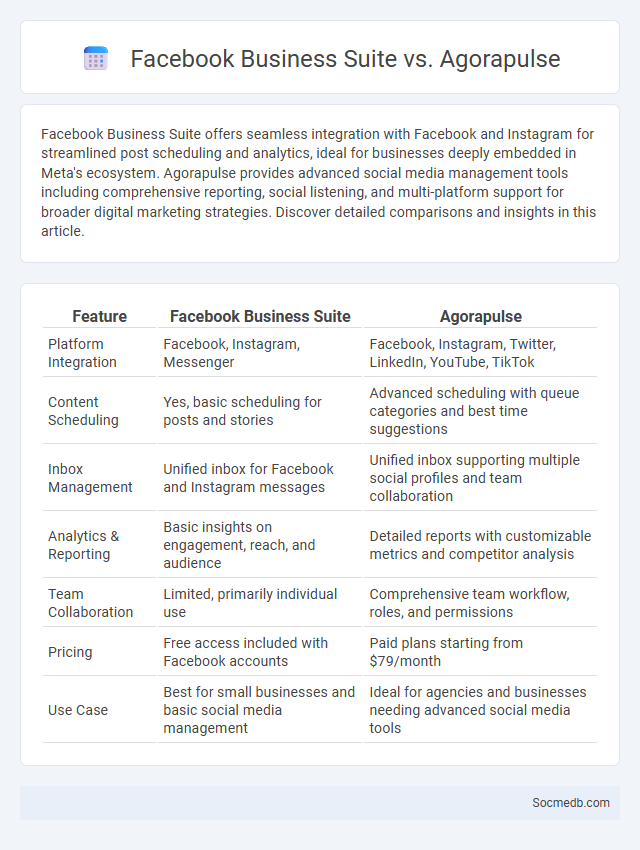
Photo illustration: Facebook Business Suite vs Agorapulse
Facebook Business Suite offers seamless integration with Facebook and Instagram for streamlined post scheduling and analytics, ideal for businesses deeply embedded in Meta's ecosystem. Agorapulse provides advanced social media management tools including comprehensive reporting, social listening, and multi-platform support for broader digital marketing strategies. Discover detailed comparisons and insights in this article.
Table of Comparison
| Feature | Facebook Business Suite | Agorapulse |
|---|---|---|
| Platform Integration | Facebook, Instagram, Messenger | Facebook, Instagram, Twitter, LinkedIn, YouTube, TikTok |
| Content Scheduling | Yes, basic scheduling for posts and stories | Advanced scheduling with queue categories and best time suggestions |
| Inbox Management | Unified inbox for Facebook and Instagram messages | Unified inbox supporting multiple social profiles and team collaboration |
| Analytics & Reporting | Basic insights on engagement, reach, and audience | Detailed reports with customizable metrics and competitor analysis |
| Team Collaboration | Limited, primarily individual use | Comprehensive team workflow, roles, and permissions |
| Pricing | Free access included with Facebook accounts | Paid plans starting from $79/month |
| Use Case | Best for small businesses and basic social media management | Ideal for agencies and businesses needing advanced social media tools |
Overview of Facebook Business Suite, Agorapulse, and Business Suite
Facebook Business Suite streamlines social media management by integrating Facebook, Instagram, and Messenger in one platform, enabling you to schedule posts, reply to messages, and analyze insights efficiently. Agorapulse offers robust social media management tools with advanced features like social listening, competitor analysis, and customizable reports, making it ideal for businesses aiming for deep audience engagement and performance tracking. Both solutions empower your brand to optimize content strategy and boost online presence through centralized management and real-time analytics.
Key Features Comparison
Social media platforms vary significantly in key features such as content format, audience engagement tools, and privacy settings. Facebook offers extensive community-building options and versatile post types, while Instagram emphasizes visual storytelling with advanced photo and video editing capabilities. Understanding these feature differences helps you choose the platform best suited to your communication goals and audience interaction preferences.
Supported Social Platforms
Supported social platforms include Facebook, Instagram, Twitter, LinkedIn, TikTok, and Pinterest, covering a wide range of social networking and content-sharing environments. Your ability to connect with diverse audiences increases significantly when leveraging these platforms' unique features and advertising tools. Effective social media strategies depend on understanding each platform's user demographics and engagement metrics to maximize reach and impact.
User Interface and Experience
A well-designed user interface (UI) in social media platforms enhances user engagement by providing intuitive navigation, clear visual hierarchy, and responsive design that adapts seamlessly across devices. Optimal user experience (UX) ensures that Your interactions are efficient and enjoyable, reducing friction points like loading times or confusing layouts. Leveraging user feedback and behavior analytics allows continuous improvements, resulting in personalized and accessible social media environments tailored to diverse audience needs.
Publishing and Scheduling Tools
Publishing and scheduling tools streamline your social media management by automating content distribution across multiple platforms at optimal times. These tools, including Hootsuite, Buffer, and Later, enhance efficiency by allowing bulk uploads, precise timing, and real-time analytics to boost engagement. Utilizing publishing and scheduling software helps maintain a consistent online presence, improving brand visibility and audience interaction.
Analytics and Reporting Capabilities
Social media analytics and reporting capabilities offer detailed insights into audience behavior, engagement metrics, and campaign performance, enabling data-driven decision-making. Advanced tools track key performance indicators (KPIs) such as reach, impressions, click-through rates, and conversion rates to optimize your social media strategy effectively. Leveraging these analytics allows you to tailor content, improve ROI, and enhance overall social media impact.
Team Collaboration and Workflow Management
Social media platforms enhance team collaboration by enabling real-time communication, file sharing, and project updates across diverse locations. Integrated workflow management tools streamline task assignments, deadline tracking, and progress monitoring, improving overall efficiency and accountability. Effective use of social media for teamwork increases productivity by fostering transparent collaboration and centralized information exchange.
Pricing and Subscription Plans
Social media platforms offer a variety of pricing and subscription plans tailored to different user needs, ranging from free basic accounts to premium packages with advanced features such as enhanced analytics, ad-free experiences, and priority customer support. Your choice depends on factors like the scale of your social media marketing efforts, budget constraints, and required tools for content creation and audience engagement. Understanding these options helps you maximize ROI and optimize your digital presence effectively.
Integration with Third-Party Tools
Integrating social media platforms with third-party tools enhances your ability to manage content, analyze performance, and automate postings efficiently. Tools like Hootsuite, Buffer, and Zapier connect multiple social channels, streamlining scheduling and engagement tracking. Leveraging API integrations empowers your social media strategy with real-time data and seamless workflow automation.
Pros, Cons, and Best Use Cases
Social media offers significant advantages such as instant connectivity, real-time information sharing, and powerful platforms for marketing and brand building. However, it also presents drawbacks like privacy risks, misinformation spread, and potential negative impacts on mental health. For your best use, leverage social media to enhance customer engagement, increase brand visibility, and stay updated on industry trends while practicing mindful usage to mitigate its downsides.
 socmedb.com
socmedb.com